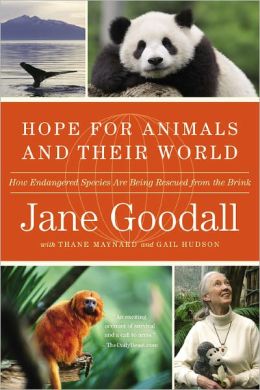"In October 2008 in Barcelona, Spain, the International Union for the Conservation of Nature (IUCN)... concluded that 'at least a quarter of mammal species are headed toward extinction in the near future.' And tragically, for many, there may be little that can be done. Yet I have been so inspired by the stories in this book and by the people who refuse to give up."
If I'd had a copy of Jane Goodall's Hope for Animals and Their World: How Endangered Species Are Being Rescued form the Brink, I would have brought him a copy. One of the world's most famous wildlife biologists, Goodall has spent years advocating for animals, especially for the chimpanzees for which she is best known. In the face of all of the challenges threatening the natural world, you'd think that would be a great way to loose faith. Instead, Goodall - along with Cincinnati Zoo director Thane Maynard - has compiled a collection of stories, describing animals which were once threatened with imminent extinction at the hands of man before being pulled back.
The stories of the species in question are grouped by theme. The first set of chapters deals with those animals which were driven to extinction in the wild, but were saved because of captive populations in zoos, including some of the stories already shared on this blog, such as the reintroduction of the California condor and the reintroduction of the red wolf. Several of the other chapters describe the roles that zoos have played in saving animals from extinction, and an endorsement from a figure as well-respected at Dr. Goodall is always nice.
Some of the species highlighted are well known, such as the giant panda and the whooping crane. Others are obscure even among animal keepers, such as the pygmy hog and the Formosan landlocked salmon. It is the more obscure species that I'm especially glad Goodall included. Lots of people are willing to put up the money and the effort to save (or at least to nominally protect on paper) tigers, elephants, and other charismatic mammals. It's the smaller, less attractive, and less noticeable animals that are often in the greater danger, though - they can slip through the cracks, unnoticed and unmourned. Dr. Goodall devotes her final chapter to explaining why (even in the face of ridicule and sometimes hostility), species such as the Salt Creek tiger beetle are worth saving. In the appendix that follows, the authors give a list of ways that the average citizen can help save endangered species - supporting reputable zoos and aquariums is on the list.
Working with endangered species, whether in the field or in captivity, can lead to caretaker fatigue. It's easy to see how you could loose hope, with so many species fading away and so few people caring. A book like Dr. Goodall's, however, can serve to remind us that not all is lost. For some animals, there is hope. All it takes is for us to have the will to turn that hope into action.
Hope for Animals and Their World: How Endangered Species Are Being Rescued from the Brink at Amazon.com

No comments:
Post a Comment